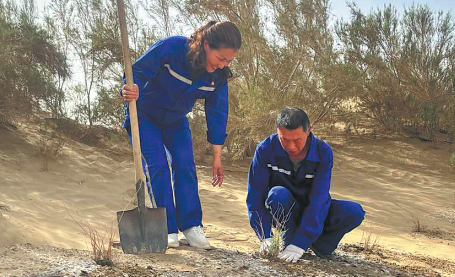Guardians are at home greening the desert
For couple looking after water station in Xinjiang, it's a lifelong commitment

On a sand dune with drought-resistant plants swaying in the wind, 58-year-old Huang Maotao and her husband crouch down and carefully check on the growth of their newly planted red willows, which stand as a part of the greenbelt along the 522-kilometer Tarim Desert Highway in the Xinjiang Uygur autonomous region.
The couple's daily tasks include inspecting irrigation pipelines, applying fertilizers and pesticides, and cleaning the area. In early spring, they plant new vegetation. This marks the third year the couple have worked as guardians for the fourth water station along China's first zero-carbon desert highway, which they have treated as their second home.
From March to October each year, the couple lives on-site to tend the water station and take care of the surrounding desert greenbelt. For the rest of the year, they go back to their hometown in Sichuan province, where Huang used to run a clothing business for three decades. After being diagnosed with glaucoma in recent years, Huang decided to quit that career and go around.
In 2022, they traveled to Xinjiang at the invitation of Huang's sister, an employee of the Tarim Oilfield of China National Petroleum Corporation, who had worked as a water station guardian along the highway since 2008. "I thought the desert would be too harsh and unbearable to live in at first," Huang said. "But when we arrived, it was better than what we had expected."
What started as a brief visit finally turned into a long-term commitment — the change happened when the couple watched and then joined the work of Huang's sister. Seeing the fragile seedling take root and flourish under their own hands, the couple chose to remain with the trees longer.
"We planted a batch of red willow seedlings on March 30," said Huang. "At first, they looked too dry to survive. Now look at them — they're thriving."
Their efforts have paid off, with the survival rate of the seedlings now standing at 80 to 90 percent, a result that brings them a strong sense of accomplishment.
Life in the station is a blend of simplicity and hardship, but the conditions have become much better. The couple now lives in a bungalow powered by solar panels that run the water pumps, irrigation system and their modest appliances.
"We've got a fridge, TV and air conditioning," Huang said. "It's much better than before, when diesel generators only provided limited and unstable electricity, with thick smoke and constant noise brought together."
They have also raised a few chickens — Huang fondly dubbed them her "desert chickens" — fed with grains and fruit scraps. In summer, passing tourists occasionally stop by, and she enjoys serving them home-cooked meals.
Still, there are difficult moments. "The toughest times come with the sandstorms," Huang said. "Even with the doors shut, it's hard to breathe, and the howling wind can be terrifying. Thankfully, this year has seen fewer sandstorms than before."
The Tarim Desert Highway stretches through the Taklimakan — the world's second-largest shifting desert. Since its completion in 1995, the highway has served as a vital route connecting Xinjiang's southern and northern Tarim Basin, cutting traveling distances by over 1,000 km.
To combat encroaching sands along the highway, the Tarim Oilfield of CNPC has put in tremendous efforts since 2003 to construct and maintain the protective greenbelt — 436 km long and 75 meters wide — on both sides of the way. Through drip irrigation, underground water is utilized to feed the drought-tolerant species such as Haloxylon ammodendron and Calligonum mongolicum.
Today, more than 100 water stations line the highway, sustaining the shelter belts which now sequester 20,000 metric tons of carbon annually — equivalent to offsetting emissions of approximately 90,000 crossing vehicles. Besides, newly installed photovoltaic power stations have enabled zero-emission irrigation over the past three years of the project.
After three years in the desert, Huang and her husband remain committed to their work. "I feel satisfied," Huang said. "Our job may seem simple, but it's valuable. We're doing our part to green the desert."


Today's Top News
- Beijing protests new US arms sale to Taiwan
- Economic growth in 'upward momentum'
- Strong ties with Thailand stressed
- Japan warned on Taiwan interference
- Takaichi's dangerous rhetoric revives Japan's militaristic past
- China expresses worry over Japan's military and security moves
































